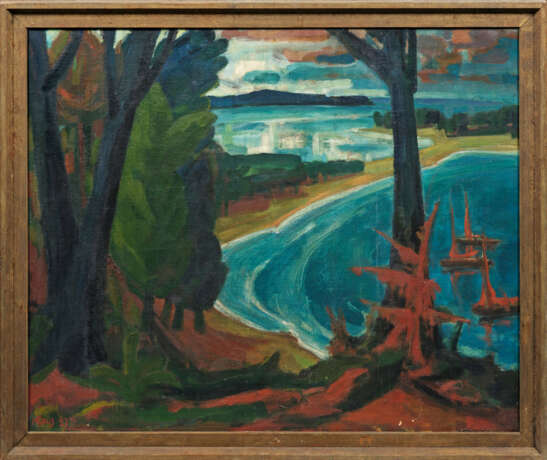ID 1277686
Lot 1943 | Max Kaus
Estimate value
€ 16 000 – 32 000
(1891 Berlin - 1977 ebenda)
"Vilm". Originaltitel
Blick auf die südlich vor Rügen gelegene kleine Insel mit seinem schmalen Landstreifen ("Mittelvilm"), der beide Inselteile verbindet. Frühe, großformatige Landschaft des bedeutenden Expressionisten, der 1922 die Insel als Motiv entdeckte, in den Jahren bis 1924 zuweilen auch mit Badenden. Die Ostsee faszinierte Kaus, regelmäßig reiste er bis in die 1930er Jahre nach Rügen, Hiddensee und Vilm. Kaus, der 1908-1914 an der Unterrichtsanstalt des Kunstgewerbemuseums und an der Akademie der Künste in Berlin studiert hatte, war ab 1916 eng mit dem "Brücke"-Künstler Erich Heckel befreundet, der ihn nachhaltig prägte. Schon kurz nach dem I. Weltkrieg hatte Kaus seinen künstlerischen Durchbruch: 1919 arrangierte die Galerie Ferdinand Möller die erste Kaus-Einzelausstellung; 1920 lernte er über Heckel auch Otto Mueller und Karl Schmidt-Rottluff kennen, mit denen er nun zusammen als Mitglied der Freien Sezession in Berlin ausstellte; auch die Kunsthandlung Alfred Heller in Berlin zeigte seine Werke 1921 neben denen von Feininger, Heckel, Kirchner, Nolde, Pechstein und Schmidt-Rottluff. Einem breiteren Publikum wurde Kaus zudem durch die Beteiligung an den Berliner Akademie-Ausstellungen 1928-1934 bekannt, 1929 erhielt Kaus dann den renommierten Villa-Romana-Preis des Deutschen Künstlerbundes mit dem hiermit verbundenen Florenz-Aufenthalt. Bereits seit 1926 lehrte er an der Kunstgewerbe- und Handwerkerschule Berlin-Charlottenburg, später an den fortschrittlich-modernen Vereinigten Staatsschulen in Berlin. Nachdem Werke von Kaus 1937 als "entartet" aus deutschen Museen entfernt worden sind, verlor auch er 1938/39 als verfemter Künstler sein Lehramt. Öl u. Tempera/Lwd.; L. u. sign. u. dat. (19)23. Verso nochmals sign, dat. u. betitelt. 95 cm x 120 cm. Rahmen.
Lit.: Sigrid Kaus und Ursula Schmitt-Wischmann: "Max Kaus. Werkverzeichnis der Gemälde", Berlin 1990, Nr. 56.
Provenienz: In den 1920er Jahren in Berlin direkt vom Künstler erworben, danach durchgehend in Familienbesitz; Auktion Grisebach Berlin, 26.11.2005, Lot 177; seitdem in deutscher Privatsammlung.
Oil and tempera on canvas. Signed, dated (19)23 and titled. Mentioned in the catalogue raisonné.
| Address of auction |
Kunstauktionshaus Schloss Ahlden GmbH Große Str. 1 29691 Ahlden(Aller) Germany | ||||||||||||||
|---|---|---|---|---|---|---|---|---|---|---|---|---|---|---|---|
| Preview |
| ||||||||||||||
| Phone | +49 5164 80100 | ||||||||||||||
| Buyer Premium | 25.0 | ||||||||||||||
| Conditions of purchase | Conditions of purchase | ||||||||||||||
| Business hours | Business hours
|



